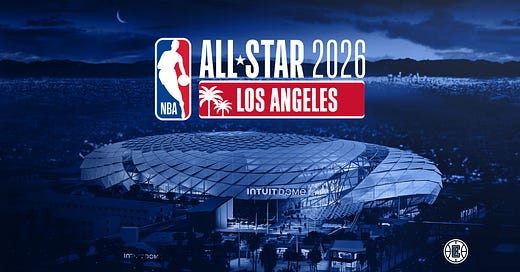Why the NBA’s New All-Star Format Might Finally Matter Again
With a USA vs. World game set for 2026, Adam Silver is trying to save the All-Star brand—and he’s betting on nationalism, time zones, and Olympic synergy to do it.
The NBA All-Star Game hasn’t felt like an “event” in years.
Despite the star power, marketing dollars, and global reach of the league, the midseason spectacle has lost its grip. It’s become a kind of basketball karaoke, with players going through the motions. And while the league kept tweaking the format, the fans kept tuning out. This year’s game was the second-least-watched in history.
Now, finally, Adam Silver is making a change that might stick.
For the 75th edition, next February, the All-Star Game will go for a USA vs. World format and air in the afternoon, strategically slotted between Winter Olympic broadcasts on NBC. Silver confirmed the shift on FS1’s Breakfast Ball, describing it as a chance to “feature some form of USA against the world.” A decade ago, this would’ve felt like a stunt. Today, it’s a commercial and cultural pivot.
Giannis. Jokić. Wembanyama. Luka. Shai. Embiid. Most of the league’s most influential stars aren’t American anymore. They don’t just hold MVP trophies or lead their teams to deep playoff runs. They shift culture. They shift markets. And they give Team USA something it hasn’t had in a while: a worthy villain. Or, depending on where you’re watching from, a worthy hero.
With Olympic basketball still fresh in viewers’ minds and patriotism running high in NBC’s coverage, the All-Star Game has a chance to ride that energy instead of competing with it. And moving the game to the afternoon is smart. No more late-night afterthought, the NBA wants prime engagement during prime hours.
And Silver’s taking notes from the NHL. Their All-Star reboot this year, the 4 Nations Face-Off, was a hit. U.S. vs. Canada in the final felt like a Stanley Cup match. Physical, passionate, and packed with geopolitical undertones, viewership topped 16 million across North America. The NBA doesn’t need fights or ice, but it does need stakes. That’s what this format provides.
Follow me for more sports and life updates: Instagram
There’s also something in it for the fans. National pride means bragging rights. And in the content economy, bragging rights mean engagement. When Giannis dunks on Tatum, or Wemby blocks Curry into the front row, fans won’t just cheer, they’ll clip it, meme it, debate it, and turn it into hours of online energy. That’s not just good for social media threads, it’s good for the NBA’s brand. It makes All-Star Weekend feel like more than a marketing campaign.
And don’t underestimate how badly this product needed help. The 2025 All-Star Game averaged just 4.7 million viewers, down 13% from the year before. The dunk contest? Once the cultural crown jewel, it has become a shadow of its former self with the league’s top names opting out year after year.
This new model doesn’t fix all that, but it refocuses the weekend. It builds narrative tension. It gives the biggest names a reason to show up beyond contract bonuses or brand obligations. Giannis has already voiced his support. Wemby seems like he’d relish it. Jokić may still prefer horse racing in Serbia, but maybe a more competitive approach will get his interest.
The timing is perfect. As the NBA continues expanding its international reach, with 125 players from 43 countries on opening night rosters last season, the need for a globally resonant event grows. Asia, Africa, Europe, South America, the Oceanic region, these aren’t just broadcast territories; they’re fandoms waiting for their All-Star moment. A USA vs. World format brings them in. Not as spectators, but as participants.
For Silver, this is more than just fixing the All-Star Game. It’s about positioning the NBA brand as both American and universal. That duality has always been tricky: rooted in the USA, but global in tone and influence. With this move, he’s embracing that tension rather than smoothing it out.
If the execution lands, if the players play hard, if the game feels meaningful, if the coverage captures the heat, it could become a fixture. Something fans look forward to every year, not scroll past. Something kids remember. Something that lives beyond highlight reels.
It’s still an exhibition. But maybe, just maybe, it finally won’t feel like one. Not completely anyway.
Thanks for reading, David Skilling.
Follow me on LinkedIn | X | Instagram
If you hit the like button, you’ll be doing me a huge favour, and if your business needs sports writing, wants to discuss advertising, or you have PR stories to pitch, feel free to get in contact.
If you know someone who will enjoy this article, please share it with them.




